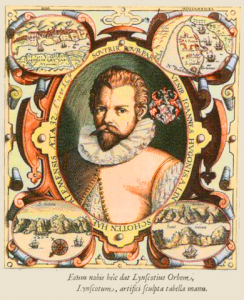By Pamela Toler (Regular Contributor)
 You know the beginning of this story. In the fifteenth century, Portugal under the leadership of Prince Henry the Navigator (a misnomer applied to him by nineteenth century British historians for nineteenth century British reasons) began maritime exploration along the coast of Africa. More or less a hundred years later, a Portuguese fleet commanded by Vasco da Gama reached India. After a certain amount of bumbling around, Portugal transformed itself as a maritime empire with a lock on the spice trade.
You know the beginning of this story. In the fifteenth century, Portugal under the leadership of Prince Henry the Navigator (a misnomer applied to him by nineteenth century British historians for nineteenth century British reasons) began maritime exploration along the coast of Africa. More or less a hundred years later, a Portuguese fleet commanded by Vasco da Gama reached India. After a certain amount of bumbling around, Portugal transformed itself as a maritime empire with a lock on the spice trade.
For almost a hundred years, the Portuguese successfully protected their control over the sea routes to the Indian Ocean. Foreign ships caught sailing to the Indies were seized and their crews sentenced to a lifetime in the galleys. Suspected spies were arrested and shipped back to Lisbon for trial; those from the Protestant countries of England and the independent northern Netherlands were charged with heresy as well as espionage.*
Things changed in 1580, when Phillip II of Spain** conquered Portugal and united the two countries. The enemies of Spain became the enemies of Portugal, especially England and the Netherlands. The two Protestant countries could no longer buy spices from Portugal. Suddenly free trade was a religious as well as a political issue. The English took the direct approach and attacked Portuguese ships as they returned from the Indies. The Dutch preferred to trade rather than raid, but establishing trade with the Indies would require information they didn’t have.
Dutch merchants sent a spy overland to the Indies. Before he returned they received all the information they wanted from a source they didn’t expect: a Dutch spy who worked right under the nose of the Portuguese.
Jan Huygen van Linschoten was a Dutch Catholic, born in the Netherlands in 1563. When he was seventeen, he went to Lisbon to work for a merchant. In 1583, he traveled to Portugal as secretary to the new Archbishop of Goa, the Portuguese capital in India.
Linschoten worked in Goa from 1584 to 1589. As secretary to the Archbishop he had access to protected information regarding trade routes and sailing conditions. He questioned any European traveler who came through “golden Goa” about the countries further east. When the Archbishop died in 1589, Linschoten began a four-year-long voyage home to the Netherlands, learning even more about the Portuguese trading empire on the way.
Back in the Netherlands, Linschoten wrote Voyages to the East Indies, an account of everything Dutch merchants needed to know if they wanted to trade in the Indies. He described the sea routes to the east, including where to get fresh water and vegetables and what time of year the weather was best for safe sailing. He explained that they would need silver to buy spices because the Asians weren’t interested in European products. He described the countries and customs of Asia from India to Japan. He even provided up-to-date maps. Most important, Linschoten revealed that the once powerful Portuguese army, which had defended the trade routes with blazing guns in the past, was no longer so powerful. The sea routes to the east were open to anyone who dared take them.
In 1595, Dutch ships sailed for Java, with a copy of Linschoten’s Voyages aboard as a guide. Portuguese control of the spice trade was over.
*A serious matter in the days when the Spanish Inquisition was more than Monty Python routine.
**He’s the guy who was married to Queen Mary Tudor from 1554 until her death in 1558, tried unsuccessfully (and illegally) to marry her sister, Queen Elizabeth II, and sent the equally unsuccessful Spanish Armada against England in 1588. He was also one of the most powerful rulers in Europe at the time.
